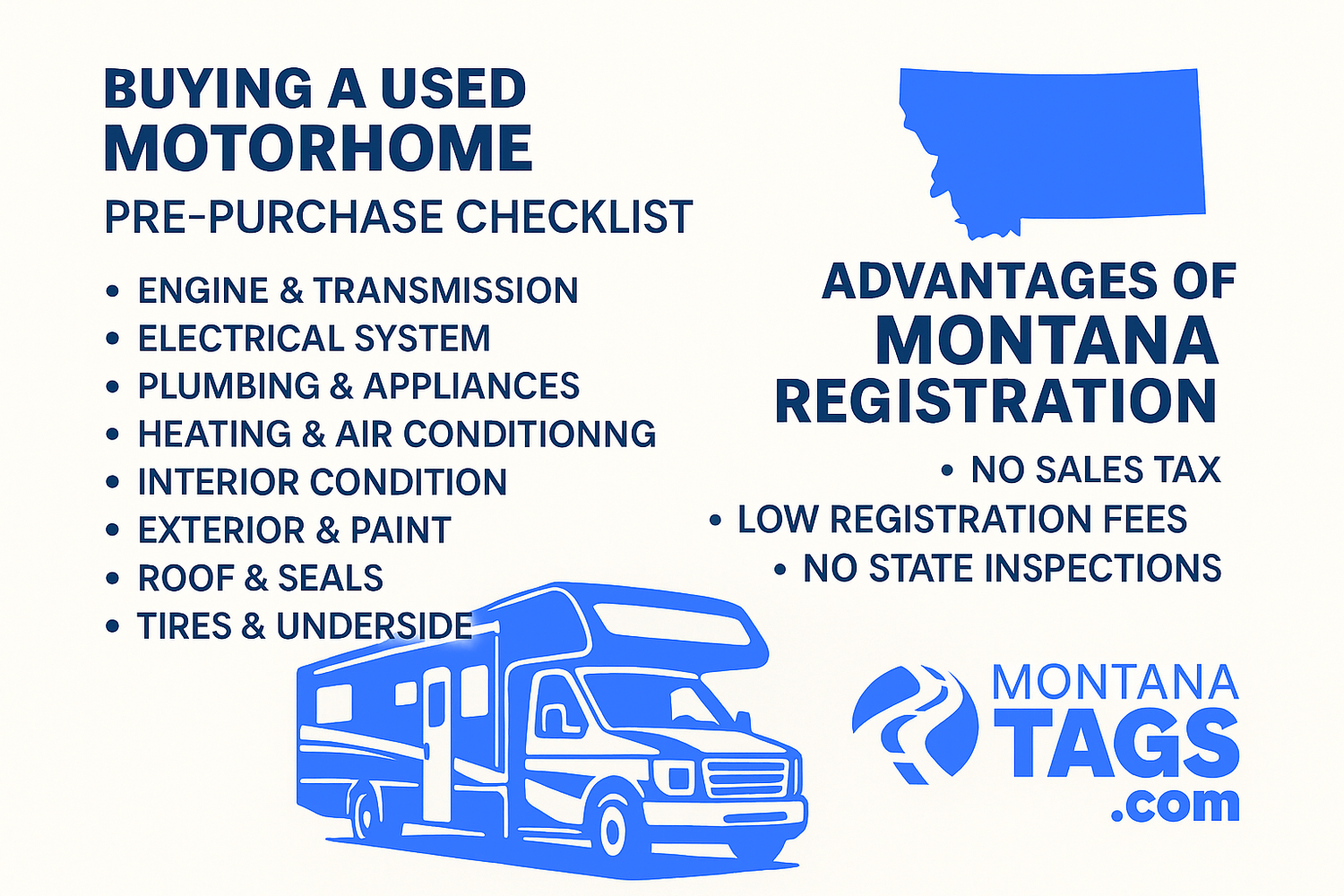Comprehensive Preowned Motorhome Inspection Checklist
1. Engine & Drivetrain
• Mileage & Service Records: Ask for detailed maintenance logs. Low mileage isn’t everything—consistent service is.
• Engine Type: Diesel (longer life, more torque) vs gas (lower cost). Check for oil leaks, blow-by, or white/blue smoke.
• Belts & Hoses: Inspect for cracks, frays, and softness.
• Cooling System: Radiator, coolant color/level, hoses, water pump—overheating can cause major damage.
• Transmission: Smooth shifting, no slipping. Pull the dipstick; fluid should be clean and red, not burnt.
• Brakes: Disc/pads wear, brake lines, and test stopping power on a short drive.
2. Chassis & Suspension
• Frame & Undercarriage: Check for rust, corrosion, or structural repairs.
• Steering Components: Play in steering wheel, worn tie rods or bushings.
• Shock Absorbers & Springs: Look for sagging or leaks.
3. Tires & Wheels
• Age of Tires: Even if tread looks good, tires older than 6 years should be replaced. DOT date code tells you manufacture date.
• Sidewall Cracks & Bulges: Indicate dry rot.
• Spare Tire Condition: Check inflation and age.
4. Exterior & Body
• Roof Condition: Look for cracks, bubbles, or signs of patchwork. Inspect roof seals around vents, antennas, and AC units.
• Side Panels & Paint: Check for fading, peeling clearcoat, body damage, or mismatched paint indicating repairs.
• Windows & Seals: Inspect for fogging, leaks, or deteriorating gaskets.
5. Interior & Living Area
• Flooring: Check for soft spots (especially near plumbing areas) indicating water damage.
• Cabinets & Furniture: Inspect hinges, latches, and upholstery for wear or moisture.
• Windows & Screens: Ensure they open/close properly and seals are intact.
• Appliances: Test fridge, stove, oven, microwave, and any slide-out trays.
6. Plumbing & Water Systems
• Water Pump & Pressure: Run all faucets and showers.
• Fresh, Grey, and Black Tanks: Inspect for leaks or odors; confirm tank capacities and sensors work.
• Water Heater: Check operation on both electric and propane settings.
7. Electrical Systems
• House & Chassis Batteries: Test voltage and age; ensure connections are clean.
• Shore Power & Generator: Test generator under load. Check hours on generator—low hours but poor maintenance can be a red flag.
• Outlets & Lights: Test every outlet, interior and exterior lighting, and any inverter systems.
8. HVAC & Comfort Systems
• Air Conditioning (Roof Units): Test cooling output and listen for unusual noises.
• Furnace: Test for heat and check ducting.
• Vent Fans: Ensure proper airflow.
9. Slide-Outs & Leveling Systems
• Slide-Out Mechanisms: Operate all slides fully, check seals and awnings.
• Hydraulic or Electric Leveling Jacks: Extend/retract to verify operation.
10. Safety Equipment
• Smoke, Propane, and CO Detectors: Ensure all are functioning and within date.
• Fire Extinguisher: Check charge and expiration.
• Escape Windows: Open easily in case of emergency.
⸻
Advantages of Registering Your Motorhome in Montana (While Living in Another State)
• No Sales Tax: Montana has zero sales tax, which can save tens of thousands on a high-value motorhome.
• LLC Registration: Using a Montana LLC lets out-of-state owners register vehicles legally in Montana while protecting personal privacy.
• Permanent Registration for Older Models: Certain RVs qualify for one-time permanent registration—no annual renewals.
• No Emissions or Vehicle Inspections: Save on recurring inspection costs and avoid emissions compliance hurdles from your home state.
• Privacy & Asset Protection: The LLC structure shields your name from public DMV databases.
• Fast & Efficient Processing: Montana counties accustomed to high-value RV registrations handle paperwork quickly.
• Lower Ongoing Costs: No personal property tax on vehicles; only a one-time plate fee for some motorhomes.

